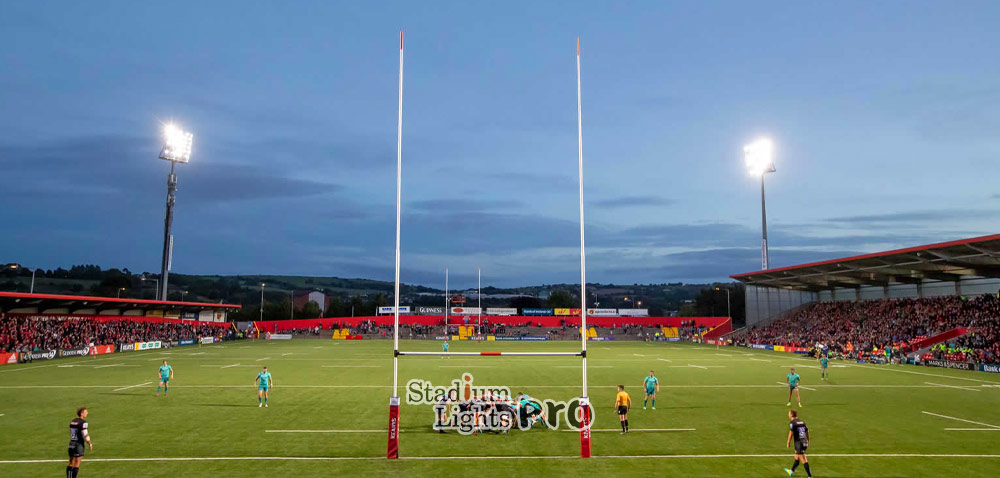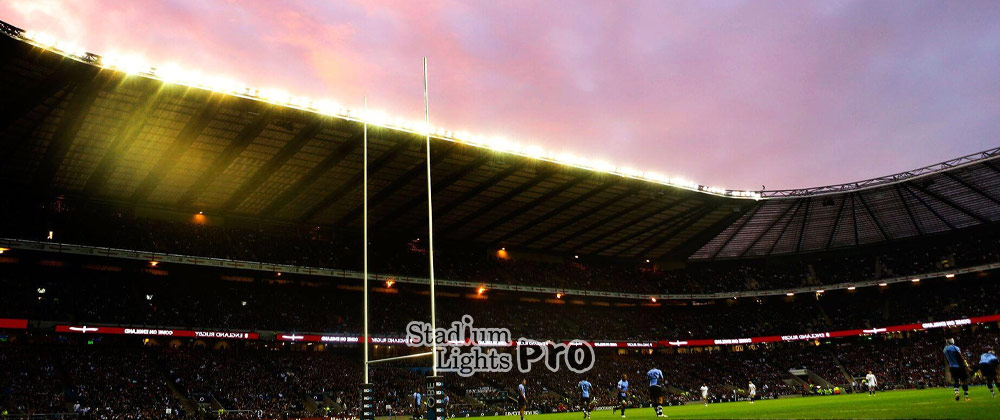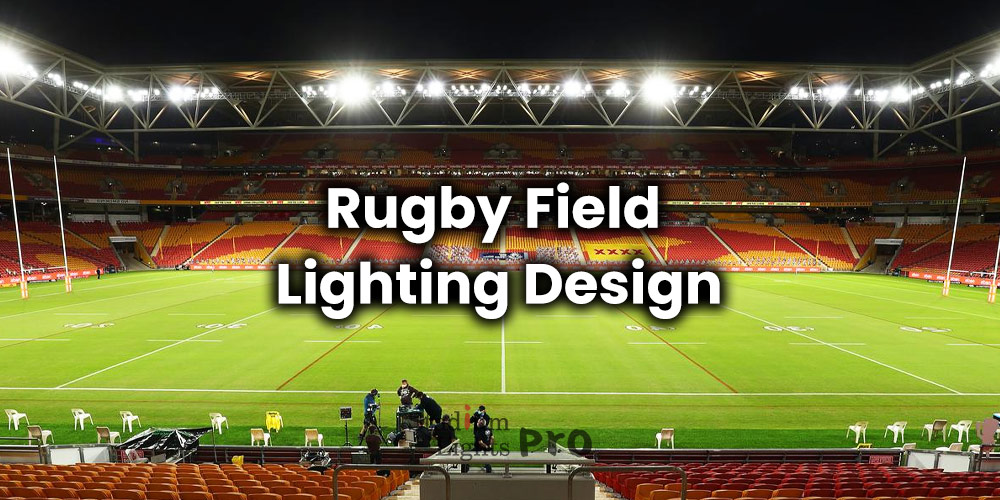Proper lighting is essential for any sporting event, including rugby. Adequate lighting allows players to see the field and each other clearly, which is necessary for safe and fair play. It also helps spectators see the game, which enhances the overall viewing experience.
In addition to the functional aspects of lighting, it can also play a role in the aesthetics of a rugby match. Well-designed lighting can create a visually appealing atmosphere and add to the overall excitement of the game.
Table of Contents
ToggleDifferent types of lighting systems available for rugby fields
Metal halide lights
Metal halide lights are a type of lighting that is commonly used for sports lighting, including for rugby fields. They produce a bright, white light and have a long lifespan, making them a popular choice for many sports facilities.
Energy usage
Metal halide lights can be energy-intensive, which can lead to higher electricity costs.
Warm-up time
Metal halide lights may take longer to reach full brightness compared to other types of lighting, such as LEDs. This can be an issue in sporting events where a quick start is essential.
Maintenance
Metal halide lights may require more frequent maintenance and replacement compared to other types of lighting, such as LEDs.
Environmental impact
Metal halide lights may contain hazardous materials, such as mercury, which can be harmful to the environment.
Cost
Metal halide lights may be less expensive upfront compared to other types of lighting, such as LEDs. However, they may have higher ongoing costs due to their energy usage and maintenance requirements.
LED lights

LED lights (Light Emitting Diodes) are a type of lighting that is becoming increasingly popular for use in sports lighting, including for rugby fields. Some of the benefits of using LED lights include:
Energy efficiency
LED lights use less energy than other types of lighting, which can lead to cost savings in terms of electricity bills.
Long lifespan
LED lights have a longer lifespan than other types of lighting, which means they need to be replaced less frequently.
Fast warm-up time
LED lights reach full brightness more quickly than other types of lighting, which can be especially beneficial in sporting events.
Durability
LED lights are generally more durable than other types of lighting and can withstand rough handling and extreme weather conditions.
Versatility
LED lights are available in a range of colors and can be used to create different lighting effects, which can enhance the atmosphere of a sporting event.
Environmentally friendly
LED lights do not contain hazardous materials such as mercury, making them a more environmentally friendly option.
High-pressure sodium lights
High-pressure sodium (HPS) lights are a type of lighting that is sometimes used for sports fields, including rugby fields. They produce a yellowish light and are not as bright as other types of lighting, such as metal halide or LED lights. They are also not as energy-efficient as other options.
Advantages to using HPS lights |
Drawbacks to using HPS lights |
|
|
Floodlights
Floodlights are a type of lighting that is commonly used for rugby field. They are mounted on poles or buildings and are designed to provide a wide area of illumination.
| Advantages of rugby field flood lights | Disadvantages of floodlights |
|
|
Floodlights can be a good option for rugby fields, provided that they are chosen and positioned carefully to provide adequate illumination and minimize any potential drawbacks.
High bay lights
High bay lights are a type of lighting typically used in high ceiling environments, such as warehouses, gymnasiums, and indoor sports facilities. They are mounted high up on the ceiling and are designed to provide a wide area of illumination.
Brightness
It is recommended to choose lights that provide sufficient brightness for the size and layout of the field. This will ensure that players and spectators can see the game clearly.
Energy efficiency
Look for lights that are energy-efficient to help reduce electricity costs.
Color temperature
The color temperature of the lights can affect how players see the ball and each other. A cooler color temperature (5000K-6500K) may provide better visibility, while a warmer color temperature (2700K-3000K) may be more comfortable for the eyes.
Glare
High bay lights can sometimes produce glare, which can be distracting for players and spectators. Look for lights that have a low glare rating to minimize this issue.
Mobile lighting systems
Mobile lighting systems are a type of lighting that is mounted on trailers or other mobile platforms, which can be moved to different locations as needed. They are typically used in situations where it is not practical or possible to install permanent lighting, such as for temporary events or in areas without access to electricity.
Temporary events
If you are hosting a one-time rugby event and do not have access to permanent lighting, a mobile lighting system can be a convenient option.
Fields without permanent lighting
If you have a rugby field that does not have permanent lighting, a mobile lighting system can be used to provide lighting for games and practices.
Fields with damaged lighting
If the lighting at your rugby field has been damaged and needs to be repaired or replaced, a mobile lighting system can provide temporary lighting while the permanent system is being repaired.
Fields with inconsistent lighting
In some cases, a rugby field may have uneven or inconsistent lighting due to its location or design. A mobile lighting system can be used to supplement the existing lighting and provide more consistent illumination.
When using a mobile lighting system for a rugby field, we need to ensure that the lights are properly positioned and secured to provide adequate illumination and ensure the safety of players and spectators.
Natural light
In some cases, it may be possible to use natural light for a rugby field. This can be achieved by designing the field and surrounding areas in such a way as to maximize the amount of natural light that is available.
| Advantages of using natural lights in rugby field | Drawbacks of natural lights |
|
|
While natural light can be a good option in certain situations, it may not be practical or sufficient for all rugby fields.
Rugby field lighting design – factors to consider

When choosing a lighting system for a rugby field, there are several factors to consider, including:
Cost of rugby field lights
The cost of lighting for a rugby field can vary widely depending on a number of factors, including the type of lighting system, the size of the field, and the location of the field.
Here are a few examples of the costs associated with lighting a rugby field:
Installation costs
The cost of installing a lighting system for a rugby field will depend on the size of the field and the type of lighting system being used. Installing a permanent lighting system may be more expensive upfront compared to a temporary or mobile lighting system.
Running costs
The ongoing costs of lighting a rugby field will depend on the energy usage of the lighting system and the local electricity rates. Energy-efficient lighting systems will have lower electricity costs compared to less efficient options.
Maintenance costs
The cost of maintaining a lighting system will depend on the type of lighting being used and the frequency of maintenance required. Some lighting systems may require more frequent maintenance and replacement compared to others.
Other costs
There may be other costs associated with lighting a rugby field, such as the cost of hiring electricians or other professionals to install or maintain the lighting system.
The cost of lighting a rugby field can range from a few thousand dollars for a temporary or mobile lighting system to hundreds of thousands of dollars or more for a permanent lighting system.
Energy efficiency
Energy efficiency is a crucial factor to consider when choosing a lighting system for a rugby field, as it can have a significant impact on electricity costs and the environmental impact of the lighting.
Choose energy-efficient lighting
Look for lighting systems that are energy-efficient and have a low energy consumption rate. LED lights and other advanced lighting technologies tend to be more energy-efficient than traditional options, such as metal halide lights.
Use energy-efficient control systems
Consider using energy-efficient control systems, such as dimming systems or occupancy sensors, to optimize the energy usage of the lighting.
Install lighting optimizers
Lighting optimizers, such as daylight harvesting systems, can help to maximize the use of natural light and reduce the need for artificial lighting.
Use timers or occupancy sensors
Installing timers or occupancy sensors can help to ensure that the lighting is only used when it is needed, which can help to reduce energy consumption.
Maintenance requirements
The maintenance requirements of a lighting system for a rugby field will depend on the type of lighting being used and the specific needs of the field. Here are a few examples of maintenance tasks that may be required for different types of lighting:
Cleaning
Most lighting systems will need to be cleaned periodically to remove dust and debris that can accumulate on the fixtures and lenses. This can be especially essential for outdoor lighting systems, which may be exposed to wind, rain, and other elements.
Replacement of bulbs
Most lighting systems will require the replacement of bulbs or other components at some point. The frequency of replacement will depend on the type of lighting being used and the manufacturer’s recommendations.
Inspection and testing
We need to regularly inspect and test the lighting system to ensure that it is in good working order and providing adequate illumination. This may involve checking the electrical connections, testing the brightness and color temperature of the lights, and looking for any signs of damage or wear.
Repair
If any issues are identified during the inspection and testing process, repairs may be required to restore the lighting system to full functionality.
Brightness
How many lux do we need to light a rugby field? Lux is a unit of measurement for light intensity, which is often used to specify the lighting requirements for sports fields, including rugby fields. The minimum light intensity required for a rugby field will depend on the specific needs of the field and the preferences of the players and spectators.
According to World Rugby, the minimum recommended light intensity for a rugby field is 750 lux. However, some sports organizations and facilities may have higher or lower light intensity requirements depending on their specific needs.
By ensuring that the field is properly lit, you can provide a safe and fair playing environment for players and an enjoyable viewing experience for spectators.
Light uniformity
Light uniformity refers to the consistency of the light intensity across a given area. In the context of a rugby field, light uniformity is essential to ensure that the field is evenly lit and that there are no shadows or areas of low visibility that could affect the play or the viewing experience.
The layout and design of the field
The layout and design of the field, including the size and shape of the field, the location and height of the lighting fixtures, and the presence of obstacles such as trees or buildings, can all affect the light uniformity.
The type of lighting system
Different types of lighting systems, such as floodlights or high bay lights, may produce different levels of light uniformity.
The position and angle of the lights
The position and angle of the lights relative to the field can also impact the light uniformity.
Color temperature
The color temperature of the lighting can affect how players and spectators perceive the field and the objects on it, such as the ball.
For a rugby field, it is generally recommended to use a lighting system with a color temperature of 5000K-6500K. This range of color temperatures is often referred to as “daylight” and is believed to provide the best visibility for sports. A cooler color temperature may help players to see the ball and each other more clearly, which can be necessary in a fast-paced sport like rugby.
The ideal color temperature for a rugby field may vary depending on the specific needs and preferences of the players and spectators. Some may prefer a warmer color temperature, which may be more comfortable for the eyes, while others may prefer a cooler color temperature for better visibility.
By choosing a lighting system with the appropriate color temperature for your rugby field, you can help to create a safe and fair playing environment for players and an enjoyable viewing experience for spectators.
Glare
Glare is the brightness or harshness of a light source that can be distracting or uncomfortable for players and spectators. In a rugby field, glare can affect the visibility of the field and the ball, as well as the overall viewing experience.
Choose lighting fixtures with a low glare rating: Some lighting fixtures are designed to minimize glare by directing the light downwards or using special lenses or reflectors. Look for fixtures with a low glare rating to help reduce the amount of glare on the field.
Use shielding or hoods
Installing shielding or hoods on the lighting fixtures can help to direct the light downwards and reduce the amount of glare on the field.
Adjust the angle and position of the lights
The angle and position of the lights relative to the field can affect the amount of glare. By adjusting the angle and position of the lights, you may be able to minimize the amount of glare on the field.
Use dimming or control systems
Dimming or control systems, such as occupancy sensors or timers, can help to adjust the intensity of the lights based on the needs of the field. This can help to reduce the amount of glare when it is not needed.
Rugby field lighting layout

The layout of the lighting poles for a rugby field will depend on the size and shape of the field, the location and height of the poles, and the specific needs and preferences of the facility. Here are a few examples of common layouts for rugby field lighting poles:
Perimeter lighting
Perimeter lighting is a type of lighting layout in which the lighting poles are located around the perimeter of the field. This can provide a wide area of illumination and may be suitable for larger fields, such as rugby fields.
| Advantages of perimeter lighting layout for a rugby field | Limitations of perimeter lighting layout |
|
|
Perimeter lighting can be a good option for a rugby field, provided that it is designed and implemented carefully to maximize the benefits and minimize any potential drawbacks.
Central pole layout
Central pole lighting is a type of lighting layout in which the lighting poles are located in the center of the field, with each pole illuminating a portion of the field. This layout can be a good option for smaller fields or for fields with obstacles such as trees or buildings that may block the light.
| Advantages of central pole lighting layout | Disadvantages of central pole layout |
|
|
Hybrid layout
In a hybrid layout of rugby field lighting, the lighting fixtures are placed both along the sides of the field (called “side lighting”) and at the ends of the field (called “end lighting”). This type of layout provides a balance between the benefits of side lighting, which illuminates the entire field evenly and reduces shadows, and end lighting, which allows the players to see the ball in flight and reduces glare.
| Advantages of hybrid lighting layout | Drawbacks |
|
|
Ultimately, the best layout for a rugby field will depend on the specific needs and challenges of the field. We need to consider factors such as the size and shape of the field, the location and height of the poles, and the intensity and uniformity of the light when designing the lighting layout.
Conclusion
Lighting is essential for the safe and enjoyable playing and viewing of rugby games and practices. It is suggested to consider factors such as field size and layout, light intensity, light distribution, pole height, light type, and control systems when designing and installing lighting for a rugby field. By ensuring that these factors are properly addressed, you can provide a high-quality lighting system that meets the needs of players, coaches, and spectators.
If you’re looking for help designing the lighting for your rugby field, we encourage you to contact us. Our team of lighting experts is here to assist you in creating a lighting plan that meets the unique needs of your field and your community. We offer free lighting design consultations, so don’t hesitate to reach out to us. We look forward to working with you to create a lighting system that enhances the experience of playing and watching rugby. Contact us today to get started.

